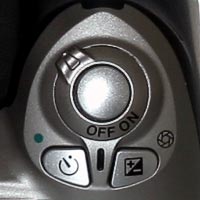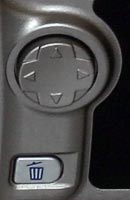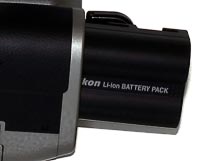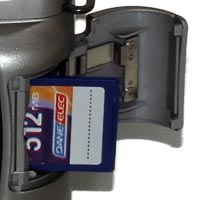Nikon D50 Review
Review Date: August 15th 2005
|
Ease of Use
When you first take the Nikon D50 out of its box, you can literally feel why this digital SLR is so cheap - its all-plastic construction makes it shockingly light, especially if you have ever used a more expensive DSLR. The same is true of the supplied 18-55mm kit lens, which again is made entirely of plastic. At this point you may be wondering if you made the right purchasing decision, but fit the body and lens together and it all begins to make much more sense. Suddenly you have a well-balanced package that is light by DSLR standards, but which doesn't feel flimsy or inconsequential. Nikon have resisted the urge to make the D50 as small as some of its main rivals, notably the Canon EOS Rebel XT / 350D and the Pentax *ist DL. Instead the D50 continues in the same vein as the D70s that I recently reviewed, with a chunky handgrip and a "business-like" design that is functional rather than pretty. The D50 is definitely designed for large hands, and this helps to negate that initial feeling of the camera being too light and plasticky. The Nikon D50 reminds me of the Canon EOS 300 film SLR, an immensely popular camera that was also made entirely of plastic. Canon sold EOS 300s by the bucketload, making it one of the best-selling film SLRs ever. Not to pre-empt the rest of this review, but I suspect that Nikon will have similar success with the D50.
Despite being aimed at the new digital SLR owner, the D50 is still quite a complex camera terms of functionality and the number of external controls that it offers, with around 20 in total and many of them having more than one function. Despite the presence of so many buttons and switches, the Nikon D50 doesn't feel too cluttered or intimidating and quickly becomes second-nature to use. The D50 is very comfortable in terms of handling. The camera has a deep, contoured handgrip on the right-hand side, coated in a rubberized compound to aid grip, that enabled me to use four fingers to hold it and my right forefinger to operate the shutter button. There is a small rubberized contoured area where your right thumb sits, with the rest of the body finished in shiny smooth silver plastic. The standard 18-55mm kit lens feels well-balanced on the Nikon D50 and it fits into place with a reassuring mechanical click. The shutter release action on the Nikon D50 is quite loud and mechanical, something that you will either love or hate. I liked it, although it isn't great for close-up candid photography as your subject will probably hear you if you get too close.
| Mode Dial | Power Switch / Shutter-release Button / Self-Timer Button / Exposure Compensation/Aperture Button |
 |
 |
The Nikon D50 is generally well-made and designed, generally using the same design as the more expensive D70s, although it has lost a few crucial things that can be found on the D50. The Exposure Compensation and Self-Timer buttons, which are located next to the shutter button, are thoughtful positioned. Hold down either button with your right forefinger and spin the dial on the top-rear of the camera with your thumb to adjust their settings - simple and intuitive. I'm not sure, however, why Nikon replaced the Metering Mode button on the D70s with the Self-Timer button on the D50, as most photographers will change the metering mode more often than selecting the self-timer or remote options. Maybe Nikon thinks that mot users of the D50 will leave it set to the default Matrix metering mode? The only design element that really disappointed was the Multi Selector (arrow pad) which felt spongy and rather unresponsive. I also disliked the positioning of the metal strap eyelet on the right of the camera body, which occasionally dug into my right hand.
Unfortunately Nikon have changed the way that the Shutter-speed, Aperture and Manual modes are implemented on the D50. Instead of having two dials as on the D70s, one just below the shutter button on the top of the handgrip which changes the shutter speed, and the Main Command dial on the rear of the camera which changes the aperture, the Nikon D50 only has the Main Command Dial on the rear. This means that it is more difficult to alter the aperture and shutter speeds when the camera is set to Manual mode, as you have to hold down the Exposure Compensation button and turn the dial at the same time to change the aperture. Most D50 users may never notice this, as they may never use the Manual mode, but more experienced photographers should take note. Other changes include the removal of the Depth of Field Preview button, Bracketing button and Focus Selector lock, again perhaps features that only more experienced photographers will miss. More annoying is the lack of illumination for the top LCD panel, which obviously makes it a little tricky to use in low-light, and the lack of a mirror-lockup feature for long exposures.
| Menu Button / ISO/Thumbnail Button / White Balance/Protect/Help Button / Image Quality/Playback Zoom/Enter Button | Multi Selector / Delete Button |
 |
 |
Considering that this is a complicated digital SLR camera with an array of advanced features, the Nikon D50 has a clean and uncluttered design that will be familiar to anyone who has used a DSLR before, although it will be intimidating for someone who hasn't used one. I counted over 20 external controls in total, so I strongly recommend that you read through the excellent user guide first, which contrary to recent trends is actually printed rather than supplied on a CD. The Nikon D50 follows conventional DSLR design in having a shooting mode dial on the top-left of the camera, which allows you to select either an advanced mode like Aperture-priority or one of 7 commonly-used scene modes.
The LCD panel on top of the camera displays a comprehensive amount of information, including the current aperture or shutter speed, flash mode, battery level, drive mode, focus point, metering, white balance and the number of remaining frames. A large number of settings are also displayed in the viewfinder, mainly in a horizontal strip along the bottom. Despite this wealth of detail, which could be rather overwhelming, the Nikon D50 does a good job of providing easily understood information about the settings that it is using.
The menu system of the D50 uses the same design and layout as the D70s and is therefore very clear and easy to use. There are 4 main menu options, Playback, Shooting, CSM (Custom Settings Menu) and Set Up, represented by both icons and text. The various options in each of the 4 menus are clearly displayed in a large font size, and cleverly the current setting for each one is shown to the right as an icon - very neat. The most complex menu is the CSM one, with 20 different options available, although many of them will only need to be set once (and you can also change the menu to "Simple" mode so that only 6 options are shown). Overall I found the menu system easy to read, understand and use - full marks to Nikon.
| Battery Compartment | Memory Card Compartment |
 |
 |
The start-up time of the Nikon D50, from turning the camera on to being ready to take a photo, is very quick for a DSLR at around 1/2 second. Focusing is also quick and consistent in good light with the standard kit lens and the camera happily achieves focus indoors and in low-light situations thanks to the powerful AF Assist light. The 18-55mm kit lens is fairly quiet in operation and feels well balanced on the D50 body. The large 2 inch LCD screen is bright, clear and has a perfectly acceptable refresh rate. It takes about 2 seconds to store a JPEG image at the highest quality setting with no discernible lockup between taking shots, allowing you to keep shooting as they are being recorded onto the memory card. For RAW images the Nikon D50 takes about 5 seconds to store an image and there is also no lockup between shots until the buffer is full - at this point you can still see through the viewfinder but you can't fire the shutter until the buffer has cleared. In the continuous shooting mode you can hold down the shutter button and take one RAW photo roughly every 0.4 seconds for up to 4 images. In the best quality JPEG mode, the capture rate is largely dependent on the memory card that you are using - I managed to take around 10 images at the same rate of one every 0.4 seconds.
Once you have captured a photo, the Nikon D50 has an excellent range of options for playing, reviewing and managing your images. You can scroll through the images that you have taken, view thumbnails (in 2 different sizes), zoom in and out up to a magnification of 5x, and view detailed information about each image by pressing left or right on the Multi-selector. You can also delete an image, rotate an image, view a slideshow, protect images so that they cannot be deleted, hide images and set various printing options. Importantly the Nikon D50 displays a histogram after taking a photo which is a great help in evaluating the exposure, plus any areas that are over-exposed flash on and off in the LCD preview to show you what you should be compensating for with your next attempt.
In summary the Nikon D50 is an all-plastic yet well constructed DSLR that is complex yet still intuitive to use. As with the more expensive Nikon D70s, the D50 inspires confidence and allows you to get on with the business of taking pictures. Nikon have largely based the design of the D50 on the superb D70s, and because of this I was impressed with the Nikon D50 in terms of its usability.
|
 PhotographyBLOG
is a member of the DIWA
organisation. Our test results for the Nikon D50 have been
submitted to DIWA
for comparison with test results for different samples of
the same camera model supplied by other DIWA
member sites.
PhotographyBLOG
is a member of the DIWA
organisation. Our test results for the Nikon D50 have been
submitted to DIWA
for comparison with test results for different samples of
the same camera model supplied by other DIWA
member sites.
